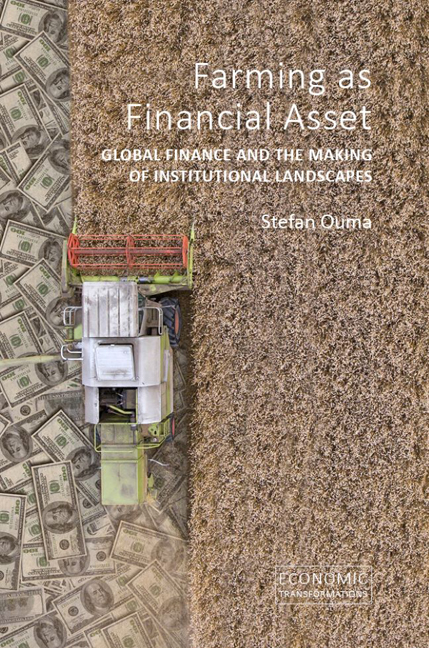Book contents
- Frontmatter
- Contents
- Preface
- Acknowledgements
- List of illustrations
- 1 Introduction
- 2 Optic: how do we study the finance– farming nexus?
- 3 History: how old is the finance– farming nexus?
- 4 Numbers: what we know (and do not know) about finance-gone-farming
- 5 States: how are foreign investments in farming regulated and accounted for?
- 6 Value(s): why has the road to “greener pastures” been so bumpy?
- 7 Delegation: what happens inside the agri-investment chain?
- 8 Grounding: what does assetization look like from below?
- 9 Radices: food futures, with or without finance as we know it?
- Epilogue
- References
- Index
8 - Grounding: what does assetization look like from below?
- Frontmatter
- Contents
- Preface
- Acknowledgements
- List of illustrations
- 1 Introduction
- 2 Optic: how do we study the finance– farming nexus?
- 3 History: how old is the finance– farming nexus?
- 4 Numbers: what we know (and do not know) about finance-gone-farming
- 5 States: how are foreign investments in farming regulated and accounted for?
- 6 Value(s): why has the road to “greener pastures” been so bumpy?
- 7 Delegation: what happens inside the agri-investment chain?
- 8 Grounding: what does assetization look like from below?
- 9 Radices: food futures, with or without finance as we know it?
- Epilogue
- References
- Index
Summary
In 2018 Ernst & Young, the prominent accountancy firm, published a summary of a larger study on the travails of private equity in Africa, titled “From origination to exit, how much value can your capital create?” (see Awadh 2019). In a way, the brief's title espouses a key question that this book has also been concerned with, that of what happens between M and M’? The space “in between” these moments within “the genealogy of capital” (Martin et al. 2008: 122) is not just filled with speculation and the production of “fictitious value”, as frequently claimed in the more critical literature. Many “alternative assets” gain financial worth only if they produce real output and income. Although certain activities of finance are not dependent on generating material things (e.g. the trade of arbitrage), this is not true for capital placements in agricultural ventures, including farmland. For financiers, the value of “land … is a multiple of its expected cash flows” (Elworthy 2012), an assertion that holds also true for businesses-turned-financial-assets further up-and downstream in the agricultural value chain.
This chapter offers a grounded understanding of how institutional landscapes are created. Rather than abstracting from the case studies and risk losing touch with the inner lifeworld of capital (and the processes that occasionally disrupt its reproduction), I present a range of “diagnostic events” (Moore 1987) drawn from Cases 3, 5, 1 and 2. These are a series of thick descriptions, which allow the reader to gain a more intimate understanding of how investors “prepare the ground” for assetization, as well as how the logics of financial value extraction gradually become grounded in particular places. These will be complemented by more cursory insights from the remaining case studies. I will show how, despite being part of particular investment chains and place-specific “asset histories”, each of the cases presented here plugs itself, more or less coherently, into the structures of the private-equity-oriented money management industry, which, in and beyond the “AG investment space”, often operates along similar lines.
- Type
- Chapter
- Information
- Farming as Financial AssetGlobal Finance and the Making of Institutional Landscapes, pp. 137 - 166Publisher: Agenda PublishingPrint publication year: 2020

